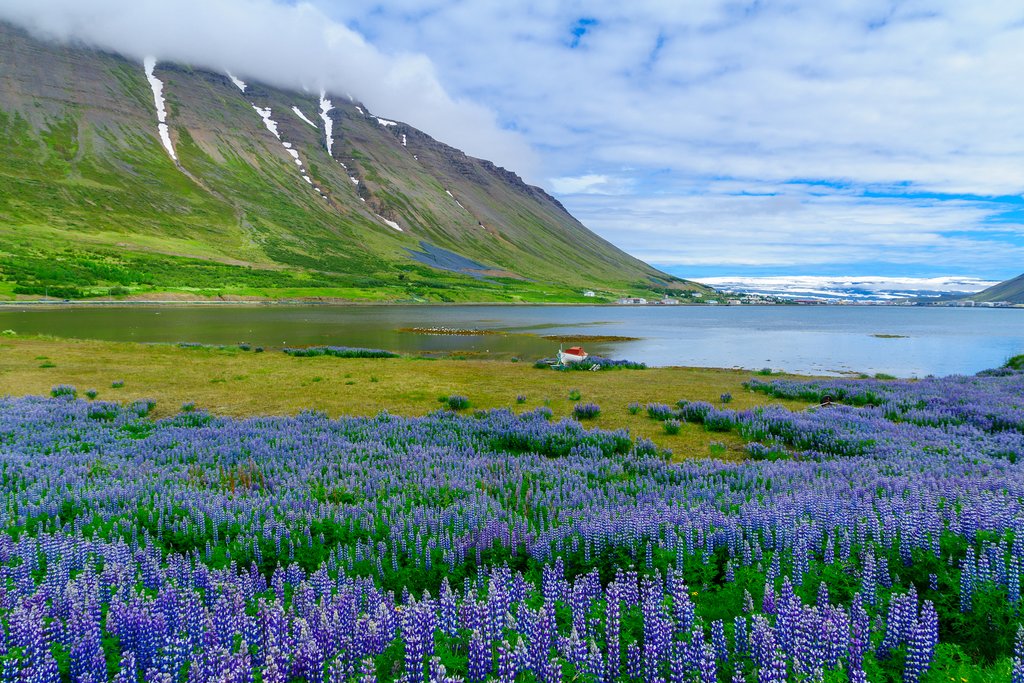Weather
Spring is full on come the end of the month. May is especially a wonderful time to visit Iceland as nature comes to life with blossoming lupine flowers, roaring streams and waterfalls, and baby animals, like the puffin. The fresh scent in the air and long daylight hours create a happy buzz around Iceland as temperatures creep into the 40s Fahrenheit during the day. Pack your shades as the sun sets around 11:30 pm and rises before 3:30 am providing endless sunsets and sunrises.
The weather, overall, is slightly less changeable with only 11 days of rain on average and sudden storms are rarer than in winter so you’ll want to wear layers and have a wind and waterproof jacket on hand.
Crowds & Costs
The last month before you see a noticeable uptick in prices makes May one of the best months to snag a decent hotel rate and plane ticket while the weather and longer daylight hours are relatively nice for outdoor activities and sightseeing. Minor roads are likely accessible toward the end of the month granting an all-access pass to the country. And if that wasn’t good enough, you aren’t likely to run into as many fellow travelers as compared to June, July, and August.
Chat with a local specialist who can help organize your trip.
Where to Go
May’s warming weather makes it a great month to explore Iceland by foot, rental car, fjord cruise, kayak, and horse with less-traveled roads opening up after the long winter season, though the Central Highlands are likely still inaccessible. Most travelers begin and end their stay in Reykjavík. Home to design-forward architecture, cool boutiques, trendy restaurants, and plenty of Viking lore, the capital is a great jumping off point to popular attractions in the Reykjanes Peninsula, like the Golden Circle and South Shore.
While on the southwest coast consider a trip to the town of Vestmannaeyjar on Heimaey island, if not for its remote and geographical beauty, then for the colorful nesting puffins. And now that the road conditions are more favorable, return to the mainland and continue along the Ring Road to Akureyri, the capital of Northern Iceland, and another access point to notable sites, including Lake Mývatn for your choice of volcanoes, geothermal hot springs, caves, and lava fields.
If following the Ring Road, a trip to Húsavík on Skjálfandi Bay in north Iceland should not be missed before carrying on clockwise around the island. Go at your own pace stopping periodically to explore the island’s highlights, like Dettifoss, Europe’s most powerful waterfall, Seyðisfjörður on the innermost point of the Seyðisfjörður fjord on the east coast and Höfn to stretch the legs, have a cocktail, and admire views on Ósland from the Seaman’s Monument.
What to Do
With the warmer weather and longer daylight hours, there is much to do in Iceland. Explore cities like Reykjavík, Akureyri, Kópavogur, Hafnarfjörður, Siglufjörður, and Húsavík for the best museums, restaurants, and drool-worthy natural attractions. Here’s a guide on what to do in Reykjavík. Renting a car is your best bet for taking advantage of the bonus daylight, so get into the countryside and discover coastal villages along rugged fjords and fairytale-esque turf houses and churches toward the interior.
Sporty types should consider a rafting excursion on the Hvítá River in the Gulfoss Canyon and hiking in Þórsmörk on the stunning Fimmvörðuháls trail or do a combination of hiking and camping in Þríhyrningur in the country’s southwest. For a truly unique and adventurous experience, consider a day of heli-skiing in Iceland’s Troll Peninsula.
Alternatively, join a responsible whale watching tour and board a (quiet) wooden boat to seek out one or two of the two dozen cetacean species. Faxaflói Bay off of Reykjavík is a great option, though if you’re in the north, consider a visit to Húsavík, known for its sightings of multiple species. Preclude your venture with a visit to the Húsavík Whale Museum.
Events in May
Labor Day (or May Day). Head to Reykjavík to watch locals participate in a march with homemade signs, exercising their right to protest (about anything).
Listahátíð í Reykjavík (Reykjavík Arts Festival). For 16 days in mid-May (sometimes in June) the capital city comes to life with artists, theater, music, and crafts. World famous singers join their lesser-known Icelandic counterparts and offer free concerts in Reykjavík’s parks and open areas.
Saga Fest. A progressive two-day music and art’s festival near Selfoss at Stokkseyrarsel farm. The annual event aims to connect Icelanders to each other and nature through storytelling, dance, meditation, yoga, and poetry readings.
Vaka Folk Festival. Taking place in Akureyri in late May (sometimes into June), this four-day event offers traditional music and song performances, like rimur ballads, played on the langspil and fiðla, singing and instrumental workshops, and open jam session.
More Helpful Information
Iceland in April
Iceland in June
Best Time to Visit Iceland
More Iceland Itinerary Ideas
